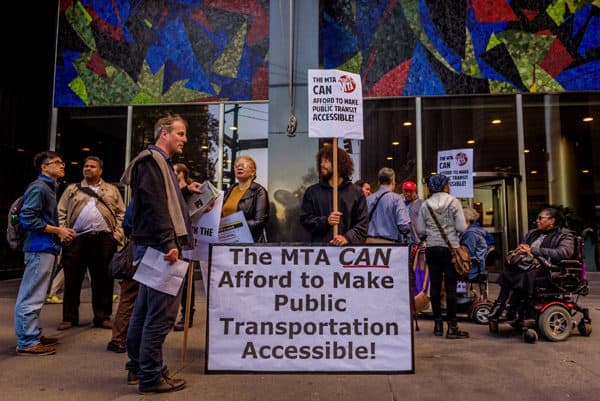Blackness as Disability
Jared Taylor, American Renaissance, February 2, 2018
Kimani Paul-Emile is a light-skinned black woman who teaches law at Fordham Law School. Since graduating from Brown University in 1993 and getting a law degree from Georgetown, she has been showered with countless honors and fellowships, and in 2016, she co-founded the Center for Race, Law, and Justice at Fordham. “Just suing isn’t going to get you there,” she explained at the time, noting that “it requires a broader approach” to correct “the racial disparities and inequality that threaten our democracy and system of justice.”
Prof. Paul-Emile has been as good as her word. She has come up with a novel approach to correcting “racial disparities” that exemplifies the inexhaustible inventiveness of the leftist imagination. In a paper called “Blackness as Disability?” she proposes a radical expansion of the grounds on which minorities — but especially blacks — should get special treatment.
When the paper was first announced, only its abstract was available, and Breitbart and The College Fix mocked it as yet another example of fanciful academic lunacy. The full, 73-page paper is now available, and it is stuffed with legal citations and footnotes. This woman is serious: She is proposing a new way of treating race that would give blacks — and perhaps other non-whites — massive benefits. In a country that has managed to turn anti-discrimination laws such as the Civil Rights Act of 1964 into justifications for discriminating against whites, it is entirely possible that a “progressive” administration would try to implement her proposal.
The very first lines of the article set out Prof. Paul-Emile’s perspective:
Is being black in the United States today a disability? This may seem a startling question, but it accurately reflects what black, as a racial designation, is and was designed to be: disabling. Racial categories were created explicitly to serve as a caste system to privilege some and disadvantage others. Within this system, racial minority status was devised to limit opportunity, participation, and achievement, and it continues to do so in many areas of social and economic life.
Prof. Paul-Emile concedes that blacks now have equal legal rights and that deliberate discrimination is rare and widely denounced, but insists that legal equality isn’t enough. It “failed to combat the predominant forms of discrimination that harm minority populations: unconscious bias, stereotyping, and structural inequality,” all of which work their harm “in the absence of intentional discrimination.” [emphasis added] White people may no longer want to keep black people down, but the racial “caste system” they built is so powerful it continues to oppress black people anyway.
This is now the standard leftist view. Outright “oppression” of blacks is impossible to find. There are no laws that directly disadvantage them. Even neutral laws that are said to have a disproportionate impact on them such as voter ID requirements or felon disfranchisement are struck down by judges. Despite endless talk of “institutional racism,” who can name a single institution with a structure that is inherently biased against blacks? In America today, oppression requires no oppressors and no mechanisms of oppression. It is proven — conclusively — from the mere fact of racial inequality.
This explains why Prof. Paul-Emile thinks the traditional legal approach to fighting discrimination does not work. It has two fatal limitations. First, it “focuses on malicious intent.” It is almost impossible to prove malicious intent because nearly all the oppression from which blacks suffer is unconscious; actual racists are vanishingly rare. The second limitation of anti-discrimination law is that it “promotes the impractical norm of colorblindness.” The US Supreme Court has taken the unreasonable position that if racial discrimination in favor whites was bad, racial discrimination in favor of blacks is bad, too. It has ruled that the obvious solutions to the problem of black oppression — special treatment for blacks — is legal only in very limited ways that pass “strict judicial scrutiny.” That is, they have to achieve a “compelling governmental interest” and they have to be “narrowly tailored” to further that goal. Outright race preferences rarely meet such a high standard.
Colorblindness may sound fair, but colorblindness is precisely the problem. Prof. Paul-Emile argues that the very idea of race is a false one that was concocted to hold black people down. Until we recognize this, colorblind solutions will fail: “By failing to acknowledge that racial classifications were designed to function as a caste system, the intent doctrine and colorblindness flatten racial difference, giving all distinctions a false equivalence.” By “false equivalence” she means that the Supreme Court fails to understand the moral difference between evil discrimination against blacks and necessary and legitimate discrimination in favor of blacks. As she notes, courts have even been so unreasonable as to disallow remedies that favor blacks because they hurt whites.
Brutal racial inequalities therefore persist. What to do?
For Prof. Paul-Emile, the solution is “hiding in plain sight:” apply disability law instead of anti-discrimination law. Prof. Paul-Emile recognizes that this was not Congress’s intent. She suspects Congress passed protections for people with disabilities only because “progress in achieving equality and opportunity for marginalized populations has been limited to moments when the interests of white elites ‘converge’ with those of disadvantaged communities.” Self-centered white men passed laws to protect the disabled because they recognized “that any able-bodied person, themselves included, could at any time become physically or mentally disabled due to chance, age, illness, or accident. But these same legislators were likely quite certain that they would not become black if they were not so already,” so they refused to provide the same remedies for blackness.
However, Congress gave the President broad powers to interpret disability laws and “under a progressive executive branch, DOJ could construe the law to cover black people.” In other words, you could wake up one morning under a Kamela Harris administration and find that someone like Eric Holder had smuggled in broad preferences for blacks through the legal back door by designating blackness as a “disability.”
Laws such as the Americans with Disabilities Act (ADA) prohibit job discrimination against otherwise qualified people with disabilities that “substantially limit” their ability to perform “one or more of the major life activities.” An employer has to make “reasonable accommodation” so that the disabled person can do the job. Classic examples are putting in ramps and special toilet stalls for people in wheelchairs, or replacing warning buzzers with warning lights so that deaf people get the message.
Treating blackness as a disability would be huge boost for blacks. As Prof. Paul-Emile points out, with disability law, you almost never have to prove malicious intent, only that “even neutral actions, policies, and programs . . . institutions, and norms can ‘substantially limit’ a person’s ability to perform ‘one or more of the major life activities.’ ” Curbstones may seem neutral, but if they don’t have cuts in them, it’s hard for people in wheelchairs to cross the street. Disabled people don’t have to prove malice, only that uncut curbs limit a major life activity.

Credit Image: © Erik Mcgregor/Pacific Press via ZUMA Wire
What’s more, disability law is very clear about something else: People without disabilities are forbidden to bring suit claiming that special treatment for the disabled discriminates against them. People who are legally blind get special tax deductions. People in wheelchairs get the best parking. If you can see and walk, and think this kind of special treatment discriminates against you, too bad. Likewise, if blackness were a disability that brought special treatment, white people would be barred from bringing suit on the basis of “reverse discrimination.”
Prof. Paul-Emile notes that “the principle that equality sometimes necessitates treating people differently has generated much rancor in the context of affirmative action.” She entirely accepts the principle of treating people — especially blacks — differently in order to treat them equally, and moving remedies to the realm of disability law would make them legally unassailable.
A recognized disability is a condition. If you have it, you benefit, and no one else can do anything about it. That is the status Prof. Paul-Emile wants for blacks.
We think of a disability as a physical or medical condition. Some examples recognized by law are missing limbs, autism, cancer, cerebral palsy, diabetes, epilepsy, multiple sclerosis, muscular dystrophy, depression, bipolar disorder, post-traumatic stress syndrome, obsessive compulsive disorder, and schizophrenia. Prof. Paul-Emile explains how blackness fits in:
Disability law recognizes that many conditions understood as disabling do not necessarily arise from a medical condition, but are instead traits that create disadvantage when combined with an inhospitable social or physical environment. . . .
Blackness becomes disabling once situated within particular social contexts. . . .
[S]ome conditions that we consider disabling are not inherent impairments, but are instead just traits that, when coupled with an unwelcoming social setting, can create disadvantage. Disability laws are not concerned about whether this process occurred intentionally or consciously, only that it disables certain individuals . . . .
In Prof. Paul-Emile’s view, being black is not, of course, a defect; it becomes a disability only in a “white supremacist” environment. And she has no trouble proving to her own satisfaction that blackness limits the ability of black people to perform “one or more of the major life activities,” as the law requires for a condition to be a disability. She cites the usual statistics on incarceration, poverty, and drug arrests, as well as studies purporting to show that racism gives black people low birth weight and chronic pain, makes them fat, shortens their lives, and gives them high infant mortality rates. This is all due to the relentless racism that relegates blacks to bad schools, polluted neighborhoods, poverty, jail, etc. Every difference in achievement between blacks and whites is due to the racism, white supremacy, and oppression that went into creating the “racial caste system” designed to hold blacks down.
The concept of disability law puts all this in clear focus: “In the same way that society was developed by and for the non-disabled, so too has it been structured in a way that privileges Whites, who have a competitive advantage in an unequal playing field on which Blacks struggle to compete.” Disability law points the way to a solution: “[I]t provides a mechanism for identifying the ways in which social institutions, policies, and norms have been shaped — consciously or unconsciously — in a way that benefits one racial group at the expense of another.”
How would applying the concept of disability work in practice? Here Prof. Paul-Emile shows astonishing lack of imagination. She wants black schools to be brought up to the standard of white schools, and black students to be put into gifted programs as often as they actually deserve. She also wants police racial profiling — already illegal — stopped. This would mean an end to “stop and frisk.” For someone who claims that “the blackness-as-disability framework holds tremendous promise for rethinking racial inequality across many sectors of society,” this is uninspiring.

Credit Image: © John M. Mantel/ZUMA Press
I can do better. To begin with, we should bring back race norming. It was used with brilliant effect on a standardized test called the General Aptitude Test Battery (GATB). This was a reliable test that had been used since 1947 to evaluate candidates for a broad variety of jobs. Like all valid tests, whites got better scores than blacks, which was embarrassing. So in 1981, the US Department of Labor solved the problem.
If a black, a Hispanic, a white, and an Asian each got the same GATB raw score of 300, their reported scores went through a process called “ethnic adjustment.” The black would be ranked in the 87th percentile, the Hispanic in the 74th, and the white and Asian together at the bottom in the 47th percentile. The test could then be used to give the job to the black. He was, after all, in the 87th percentile for blacks, and was therefore a much better candidate — after race norming — than the white who got the same score but was only in the 47th percentile for whites. For a white to be considered the better candidate, he would have to be in at least the 87th percentile for whites and get a much higher raw score than the black.
By 1986, about 40 state governments and hundreds of private companies were race norming the GATB, but they kept it a secret from the estimated 16 million people who took the test. Companies that hired through state employment agencies often got race-normed candidate profiles without knowing it.
Congress got wind of what was going on and banned race norming in 1991, but it is an obvious solution to black disability. All tests, whether for drivers licenses, the bar, AP classes, hair dressers’ licenses, or the SAT should be race normed. After all, race differences in scores are the result of white supremacist oppression and do not reflect actual differences in ability; nor are they the result of malicious intent by people giving the test. Race norming would be a dramatic but obvious remedy to the persistent, unintended structural inequality Prof. Paul-Emile wants to correct.
There are other quantitative remedies. It is well known that blacks have an average IQ of 85 compared to a white average of 100, but this difference is a measure of structural inequality, not ability. This false indicator of intelligence ranks the average black at the 16th percentile of white ability. For virtually every job in every profession, black workers — especially those hired according to race-normed criteria — should get full marks for performing at the 16th percentile of job performance for whites. This would be “reasonable accommodation” to the disability from which blacks suffer.
Other measures could be taken that whites could not oppose in the name of “reverse discrimination.” Structural bias in the criminal justice system could be reduced if black defendants always had black, court-appointed counsel, were tried only before black judges, and had juries that were at least 50 percent black. Perhaps all municipal police chiefs could be black. Media could be cured of unconscious bias if at least 13 percent of writers, editors, and producers were black. All companies over a market capitalization of, say, $100 million could be required to have a certain number of black board members. All non-profit corporations could be required to show how their tax-exempt status benefits blacks.
There could be financial remedies. Prof. Paul-Emile writes that American society has “been structured in a way that privileges Whites, who have a competitive advantage in an unequal playing field on which Blacks struggle to compete.” What more straightforward way to level the playing field than to impose sales taxes or property taxes, for example, only on whites, or to require whites to pay a supplemental “privilege tax” over and above their income tax liability?
Surely Prof. Paul-Emile and her colleagues can think of more remedies, and surely Supreme Court Justices such as Sonia Sotomayor and Elena Kagan would find them all constitutional.

Supreme Court Justices Sonia Sotomayor and Elena Kagan. (Credit Image: © Prensa Internacional via ZUMA Wire)
As I see it, the only disadvantage in applying disability law to the problem of blackness is the word “disability.” Eventually the word might lose its aroma of inferiority, but for now, this field of law should be renamed “compensatory law.” This removes stigma and restores the aura of justice that best suits the law.
Of course, this is all nonsense, but it flows logically and even inevitably from the great factual void at the heart of Prof. Paul-Emile’s view of the world: the assumption that blacks and whites are precisely equal and that whites must heal themselves and their society in order to eliminate all race differences in achievement. If whites let themselves fall into permanent minority status, this view — already dominant — will be used to justify ever more draconian transfers of wealth from whites to blacks.
Earlier, I expressed surprise that Prof. Paul-Emile’s proposals for actually applying disability law were so modest. Maybe she just doesn’t want to show her hand. All my proposals are entirely consistent with her reasoning. Like the immigration reform of 1965 that promised not to change the ethnic balance but that is reducing whites to a minority, and like anti-discrimination laws that legalized discrimination against whites, “black disability” would be sold as something it is not: as part of the arsenal of justice rather than as yet another way to dispossess whites.















